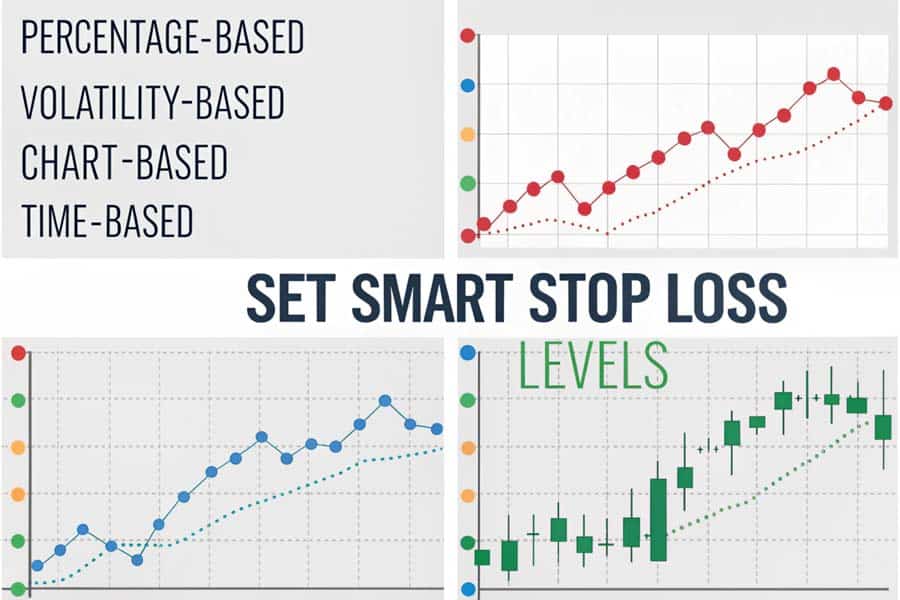Imagine waking up to find your hard-earned forex investment wiped out overnight. Scary, right? This is exactly the nightmare that a well-implemented stop loss strategy can prevent. In the high-stakes world of forex trading, where market fluctuations can be swift and unpredictable, understanding and utilizing stop loss orders is not just a good practice—it’s essential for survival and success.

What is stop loss in forex trading? At its core, a stop loss is a predefined price point at which your trade will automatically close to limit potential losses. Whether you’re a novice dipping your toes into forex with a reputable online forex broker or a seasoned trader leveraging advanced strategies, mastering stop loss orders can significantly enhance your trading performance. This comprehensive guide delves deep into the nuances of stop loss in forex, exploring various strategies, types, and advanced techniques to safeguard your investments and optimize your trading outcomes.
Understanding Stop Loss in Forex

Understand stop loss to navigate the forex market confidently.
Definition of Stop Loss in Forex Trading
A stop loss in forex is an essential risk management tool that allows traders to specify the exact price at which a losing trade will be automatically closed. This mechanism ensures that losses do not exceed a predetermined amount, providing a safety net in volatile market conditions. For instance, if you purchase EUR/USD at 1.2000 with a stop loss set at 1.1950, your position will automatically close if the currency pair drops to that level, limiting your loss to 50 pips.
Purpose and Importance of Using Stop Loss Orders
The primary purpose of stop loss orders is to protect your trading capital from significant losses, thereby preserving your ability to continue trading over the long term. Here are some key reasons why stop loss orders are indispensable in forex trading:
- Risk Management: Stop loss orders help you control the amount you risk on each trade, ensuring that no single trade can devastate your account.
- Emotional Discipline: By automating the exit point, stop loss orders eliminate the emotional aspect of trading, preventing panic-induced decisions.
- Consistency: Implementing stop loss strategies consistently contributes to a disciplined trading approach, enhancing overall performance.
- Focus on Strategy: With predefined exit points, traders can focus on executing their trading strategies without constantly monitoring the market.
In the competitive landscape of forex trading, whether you’re using a broker for forex trading or leveraging tools from a regulated forex broker, integrating stop loss orders into your trading plan is non-negotiable for sustained success.
Read More: equipment for forex trading
Types of Stop Loss Orders
Understanding the different types of stop loss orders can help you choose the most suitable method for your trading style and objectives. Here are the primary types:
1. Standard Stop Loss Orders
Standard stop loss orders are the most straightforward type. They trigger a market order to close your position once the asset reaches the specified price level. This type of stop loss ensures that you exit the trade once the market moves against you beyond your risk tolerance.
Example: If you are long on GBP/USD at 1.3000 with a standard stop loss at 1.2950, your position will close if GBP/USD drops to 1.2950.
2. Trailing Stop Loss Orders
Trailing stop loss orders are dynamic and adjust automatically as the market moves in your favor. They help lock in profits while still providing protection against adverse movements.
Example: If you set a trailing stop of 30 pips on a EUR/USD trade at 1.2000, and the price rises to 1.2050, the stop loss moves to 1.2020, maintaining the 30-pip distance.
3. Guaranteed Stop Loss Orders
Guaranteed stop loss orders provide an added layer of protection by ensuring that your trade will close at the exact price you set, regardless of market volatility or gaps. This type of stop loss is particularly useful during high-impact news events.
Note: Not all brokers offer guaranteed stop loss orders. It’s essential to verify this feature with your chosen forex broker.
Methods for Setting Stop Loss Levels

Discover methods to set effective stop loss levels tailored to your trading style.
Choosing the right method to set your stop loss levels is crucial for effective risk management. Here are four prominent methods:
1. Percentage-Based Stop Loss
This method involves risking a fixed percentage of your trading capital on each trade. For example, if you decide to risk 2% of your account on a single trade, and your account balance is $10,000, you would risk $200 per trade.
Advantages:
- Simplicity: Easy to implement and understand.
- Consistency: Maintains consistent risk across all trades.
Example: With a 2% risk on a $10,000 account, your stop loss would be set to limit your loss to $200 per trade.
2. Volatility-Based Stop Loss
This approach uses market volatility indicators, such as the Average True Range (ATR), to determine appropriate stop loss distances. By accounting for market fluctuations, you can set stop losses that are neither too tight nor too loose.
Advantages:
- Adaptability: Adjusts to changing market conditions.
- Precision: Provides a data-driven basis for stop placement.
Example: If the ATR for GBP/JPY is 100 pips, you might set your stop loss at 1.5 times the ATR, or 150 pips.
3. Chart-Based Stop Loss
Chart-based stop loss involves identifying key technical levels, such as support and resistance, and placing your stop loss just beyond these points. This method aligns your stop placement with significant market levels, increasing the likelihood that the stop will only be triggered by a genuine trend reversal.
Advantages:
- Technical Alignment: Uses established market levels for stop placement.
- Strategic Placement: Reduces the likelihood of being stopped out by normal market noise.
Example: If the support level for USD/CHF is at 0.9000, you might place your stop loss at 0.8980, just below the support.
4. Time-Based Stop Loss
A time-based stop loss closes a trade after a predetermined period, regardless of price movement. This method is useful for strategies that are time-sensitive or for trades that have not moved as expected within a certain timeframe.
Advantages:
- Discipline: Ensures trades do not remain open indefinitely.
- Time Management: Aligns with time-bound trading strategies.
Example: You might decide to close any trade that hasn’t reached its target or stop loss within 24 hours.
Pro Tip: Always review market conditions when setting stop loss levels. Blindly following a fixed approach can lead to unnecessary losses.
Forex Stop Loss Strategies

Implement winning strategies to secure profits and minimize risks with stop loss orders.
Implementing effective stop loss strategies can significantly enhance your trading performance. Here are three robust strategies to consider:
1. Using Support and Resistance Levels
Support and resistance levels are fundamental concepts in technical analysis. Support levels indicate where a currency pair tends to find buying interest, while resistance levels indicate where selling interest emerges.
Strategy:
- Long Positions: Place stop losses just below the support level.
- Short Positions: Place stop losses just above the resistance level.
Benefits:
- Aligns stop placement with significant market levels.
- Reduces the likelihood of being stopped out by minor market fluctuations.
Example: If EUR/USD has strong support at 1.1800, placing a stop loss at 1.1780 provides a buffer below the support.
2. Applying the Average True Range (ATR) Indicator
The ATR indicator measures market volatility by calculating the average range of price movements over a specific period. Using ATR helps set stop losses that accommodate current market conditions.
Strategy:
- Determine the ATR value for your chosen timeframe.
- Multiply the ATR by a factor (e.g., 1.5) to set your stop loss distance.
Benefits:
- Adjusts to varying market volatility.
- Prevents stop losses from being too tight during volatile periods.
Example: If the 14-day ATR for USD/JPY is 80 pips, a stop loss could be set at 120 pips (1.5 x ATR).
3. Implementing Moving Averages
Moving averages smooth out price data to identify trends. Using moving averages as dynamic stop loss levels can help protect profits and adapt to changing market conditions.
Strategy:
- Use a specific moving average (e.g., 50-period MA) as a trailing stop.
- Adjust the stop loss level as the moving average evolves with the trend.
Benefits:
- Provides a trend-following stop loss method.
- Helps lock in profits as the trend progresses.
Example: In an uptrend, if the price is above the 50-period MA, place the stop loss just below the MA to protect against reversals.
Read More: what is Forex demo account
Common Mistakes to Avoid with Stop Losses
Even with the best strategies, traders can make mistakes that undermine their stop loss effectiveness. Here are three common pitfalls to watch out for:
1. Setting Stops Too Close to Entry Points
Placing stop losses too near the entry point can result in premature exits, especially in volatile markets. This approach increases the likelihood of being stopped out by normal price fluctuations rather than genuine trend reversals.
Solution:
- Allow enough room for the trade to develop by using methods like ATR or chart-based stops.
- Avoid setting stops based solely on fixed pip distances without considering market conditions.
2. Ignoring Market Volatility
Market volatility plays a crucial role in determining appropriate stop loss levels. Ignoring volatility can lead to setting stops that are either too tight or too loose, increasing the risk of stop-outs or excessive losses.
Solution:
- Incorporate volatility indicators like ATR into your stop loss strategy.
- Adjust stop loss distances based on current and historical volatility.
3. Failing to Adjust Stop Losses as Market Conditions Change
Market conditions are dynamic, and what works in one scenario may not be effective in another. Failing to adjust your stop losses can result in suboptimal risk management.
Solution:
- Regularly review and adjust your stop loss levels in response to changing market conditions.
- Use dynamic stop loss techniques, such as trailing stops, to adapt to market movements.
Remember: A static stop loss strategy can limit your ability to respond to market changes effectively.
Advanced Stop Loss Techniques

Elevate your trading game with advanced stop loss techniques for maximum gains.
For traders looking to elevate their stop loss strategies, advanced techniques offer greater flexibility and control. Here are three sophisticated methods:
1. Dynamic Stop Loss Adjustments
Dynamic stop loss adjustments involve modifying your stop loss levels based on real-time market developments. This approach allows you to lock in profits while providing room for the trade to move in your favor.
Strategy:
- Start with a wider stop loss to accommodate initial volatility.
- Gradually tighten the stop loss as the trade becomes profitable.
Benefits:
- Maximizes profit potential while minimizing downside risk.
- Adapts to market conditions dynamically.
Example: After a trade moves 50 pips in your favor, adjust the stop loss to break even, then trail it by 30 pips as the trade continues to progress.
2. Partial Position Closures
Partial position closures involve closing a portion of your trade at predetermined profit levels while keeping the remaining position open with a stop loss. This technique allows you to secure some profits while still benefiting from potential further gains.
Strategy:
- Set profit targets where a portion of the trade will be closed.
- Adjust the stop loss on the remaining position to protect the secured profits.
Benefits:
- Reduces overall risk while maintaining upside potential.
- Provides a balance between profit-taking and staying in the trade.
Example: If you’re long on AUD/USD, you might close half of your position once the price reaches 1.3000 and set a trailing stop on the remaining half.
3. Combining Stop Loss with Take Profit Orders
Integrating stop loss orders with take profit orders creates a balanced exit strategy that defines both your risk and reward parameters. This combination ensures that you exit trades either at a predefined profit target or to limit losses.
Strategy:
- Set a stop loss at a level where the trade will be closed to prevent excessive losses.
- Set a take profit order at a level where the trade will be closed to secure gains.
Benefits:
- Provides clear exit points for both winning and losing trades.
- Enhances disciplined trading by removing emotional decision-making.
Example: For a EUR/GBP trade, set a stop loss at 1.1800 and a take profit at 1.2000, ensuring a favorable risk-reward ratio.
Read More: common forex trading mistakes
Pro Tips for Advanced Traders
For those who have mastered the basics and are looking to refine their stop loss strategies further, here are some pro tips to elevate your trading game:
1. Integrate Multiple Indicators
Don’t rely on a single indicator for setting stop losses. Combining multiple technical indicators, such as moving averages, Bollinger Bands, and RSI, can provide a more comprehensive view of market conditions and enhance the accuracy of your stop loss placements.
2. Use Time-Based Adjustments
Incorporate time-based elements into your stop loss strategy. For instance, if a trade hasn’t reached its target or stop loss within a specific timeframe, consider adjusting the stop or closing the trade to prevent capital from being tied up indefinitely.
3. Monitor Correlations
Understand the correlations between different currency pairs. If you have multiple positions that are highly correlated, ensure that your stop losses are set to account for the compounded risk, preventing excessive exposure.
4. Backtest Your Strategies
Regularly backtest your stop loss strategies using historical data. This practice helps you understand how your strategies would have performed in various market conditions and allows you to make data-driven adjustments.
5. Stay Informed on Economic Events
Keep an eye on major economic events and news releases that can cause significant market volatility. Adjust your stop loss levels accordingly to accommodate potential price swings during these periods.
Pro Tip: Constantly refine your stop loss strategies based on performance reviews and evolving market dynamics to stay ahead in the trading game.
Opofinance Services: The Ultimate Trading Experience
Choosing the right broker is as crucial as mastering stop loss strategies. Opofinance, an ASIC-regulated forex broker, stands out with its premium services designed to enhance your trading experience and ensure your strategies, including stop loss orders, are executed flawlessly.

- MT5 Broker Listing: Officially featured on the MT5 brokers list, Opofinance offers advanced trading tools and a robust platform for both novice and experienced traders.
- Safe and Convenient Deposits/Withdrawals: Enjoy fast, secure, and hassle-free transactions with a variety of deposit and withdrawal methods tailored for global traders.
- Social Trading Service: Leverage Opofinance’s social trading feature to copy the strategies of top-performing traders, enhancing your potential for profit while learning from the best.
- Comprehensive Support: Benefit from 24/5 customer support and a wealth of educational resources, ensuring you have the assistance and knowledge needed to succeed.
- Regulated Security: Trade with peace of mind knowing that Opofinance is regulated by ASIC, adhering to strict financial standards and ensuring the safety of your funds.
Ready to elevate your trading game? Open an account with Opofinance today!
Conclusion
In the dynamic and often unpredictable world of forex trading, stop loss orders are more than just protective measures—they are fundamental pillars that support disciplined and strategic trading. Without a well-defined stop loss strategy, traders expose themselves to unnecessary risks that can jeopardize their capital and hinder long-term success.
Implementing effective stop loss strategies not only safeguards your investments but also fosters emotional discipline, allowing you to make informed and rational trading decisions. Whether you’re a beginner using a reliable broker for forex trading or an experienced trader employing advanced techniques, mastering stop loss orders is crucial for achieving consistent and profitable trading outcomes.
Pairing your stop loss strategies with a reputable and regulated broker like Opofinance ensures that your trades are executed seamlessly, your funds are secure, and you have access to the tools and support necessary to thrive in the competitive forex market. Embrace the power of stop loss orders today and take a decisive step towards securing your trading future.
Key Takeaways
- Essential for Risk Management: Stop loss orders are crucial for limiting potential losses and protecting your trading capital.
- Diverse Order Types: Understanding and utilizing different stop loss types—standard, trailing, and guaranteed—can enhance your trading strategy.
- Strategic Placement: Employ methods like percentage-based, volatility-based, chart-based, and time-based stop loss settings for optimal risk management.
- Advanced Techniques: Dynamic adjustments, partial position closures, and combining stop loss with take profit orders can significantly improve trading outcomes.
- Avoid Common Pitfalls: Ensure stop losses are appropriately placed by considering market volatility and adjusting based on evolving conditions.
- Leverage Expert Brokers: Partnering with regulated brokers like Opofinance provides the necessary tools and support to implement effective stop loss strategies.
How can I adjust my stop loss strategy during unexpected market events?
During unexpected market events, such as geopolitical tensions or economic data releases, market volatility can spike dramatically. To adjust your stop loss strategy:
Widen Your Stop Loss: Increase the distance of your stop loss to accommodate larger price swings and prevent premature exits.
Use Guaranteed Stop Loss Orders: If available, opt for guaranteed stop loss orders to ensure your trade closes at your specified level despite extreme volatility.
Pause Trading: Consider pausing trading activities until the market stabilizes to reassess and adjust your strategies accordingly.
Can I use multiple stop loss strategies simultaneously?
Yes, integrating multiple stop loss strategies can enhance your risk management. For instance, you might use a percentage-based stop loss in conjunction with a chart-based stop loss. This layered approach ensures that your trades are protected from different angles, providing a more robust defense against adverse market movements.
Combination Example: Set a percentage-based stop loss to limit overall risk per trade, and place an additional chart-based stop loss at a significant support or resistance level to account for technical factors.
How do stop loss orders impact my overall trading strategy and performance?
Stop loss orders play a pivotal role in shaping your overall trading strategy and performance by:
Enhancing Risk Management: They limit potential losses, ensuring that no single trade can significantly harm your trading capital.
Promoting Discipline: Stop loss orders enforce disciplined trading by removing emotional biases and adhering to your predefined risk parameters.
Improving Consistency: By consistently applying stop loss strategies, you can achieve more stable and predictable trading performance over time.
Allowing Focus on Opportunities: With risk management in place, you can concentrate on identifying and capitalizing on profitable trading opportunities without constantly monitoring every trade.
Effective use of stop loss orders can lead to improved trading performance, increased confidence, and a more sustainable trading career.







